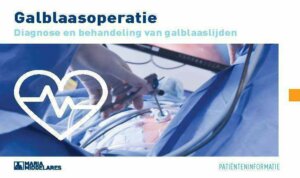Gallbladder removal
What is it?
What is it?There are two ways to remove the gallbladder: a keyhole surgery or a classic incision.
Course of the procedure
Course of the procedureIn the majority of cases, the gallbladder is removed with a keyhole surgery or laparoscopy. For this procedure, the abdominal cavity is inflated with carbon dioxide gas. Afterwards, a camera is introduced into the abdominal cavity via the navel. Using fine instruments, the gallbladder is then cut loose and removed through three small incisions. The entire procedure is monitored on a large video screen. This allows the whole surgical team to follow exactly what is happening inside the abdomen.
The advantage of this technique is primarily due to the limited incisions, which makes for a quick recovery after the surgery.
Sometimes, it is not possible to safely remove the gallbladder through keyhole surgery. For example, this may be the case with patients who have already had procedures on the upper abdomen, which has led to adhesions. In cases where the gallbladder is severely infected, the anatomy is also problematic, and a classic incision is made under the rib arch. There is the chance that the surgeon will decide to switch to a conventional surgery (open incision) during the procedure.
After the surgery
After the surgeryThe hospitalisation duration depends on a number of factors.
- Age
- General condition of the patient
- Home situation (e.g. living alone)
- Patients who have undergone surgery via an incision below the rib arch will often remain in hospital a bit longer.
- Patients who are administered antibiotics for gallbladder inflammation after surgery often stay in hospital a little longer.
- Patients who were treated with a keyhole surgery for uncomplicated gallstones can go home soon. In fact, sometimes the procedure is performed as part of a day admission.
See below for additional information about discomfort and some practical advice.
Wound pain after a surgical procedure is normal, to a degree. This pain may persist for a week or even for a number of weeks when coughing or lifting things. This pain may persist for a week or even for a number of weeks when coughing or lifting things. Feel free to use pain relief during this period. The intensity of the pain should decrease progressively. If the pain increases, the wounds must be checked partway through. Contact your GP or surgeon for this.
Shoulder pain can arise after any keyhole surgery. This may be the result of the patient’s positioning during the procedure, but also because the abdominal cavity is inflated with carbon dioxide. The stretching of the midriff may result in irritation of the nerve to the shoulder. This shoulder pain is no cause for concern and usually disappears after a few days.
Sutures may be removed by the GP on the tenth day after the procedure. Until then, make sure to protect the wounds from contact with water. Bandages may be changed when they are soiled or loosened.
If there was an infection or blood loss during the procedure, the surgeon may decide to leave a drain (plastic tube) at the surgical site. The plastic tube drains any excess fluid. This drain will then be removed before the patient’s discharge. Only in very exceptional cases does the drain have to be kept in for a longer time.
Exercise is indicated as soon as the level of pain allows. Early mobilisation reduces the chance of clots forming in the blood vessels. Movement should be done within the pain threshold. It is best to wait three weeks before doing any sports. For a few weeks after the procedure, you may become tired more quickly.
After surgery, the main gallbladder takes over the function of the gallbladder. As it gradually widens, it can store more and more bile. For this reason, the majority of patients will not have any trouble digesting fats and alcohol after the procedure. Only a minority of patients need to follow a diet after the surgery. It is recommended to limit fat intake for the first few days. The main bile duct often needs some time to compensate for the loss of the gallbladder reservoir.
Potential risks
Potential risksWound infections can also occur after a keyhole surgery. Especially at the umbilical incision, there is an increased risk of infection. This is because the wound is usually stretched quite a lot in order to remove the gallbladder. If the pain at the incision sites increases, or if there is redness or foul-smelling discharge, it is best to schedule wound check for as soon as possible.
Patients who have undergone surgery for an infected gallbladder may develop an infection in the surgical area afterwards. This manifests mostly as increasing pain under the rib arch, as well as a generalised sick feeling and fever. Blood tests show elevated infection levels. Medical imaging may show an encapsulated fluid collection. Usually, the infection can be treated with antibiotics. In some cases, it is necessary to evacuate the fluid collection using a puncture guided by ultrasound or a CT scan. Sometimes a repeat surgery is necessary.
Post-operative bleeding can occur in the surgical area under the liver or at the small incision in between the abdominal muscles. It is common that an encapsulated blood clot (e.g. haematoma) forms when there is limited blood loss. No further treatment is required.
Only if there is an infection of the haematoma is a repeat procedure or a puncture indicated.
Severe blood loss usually manifests with an elevated heart rate, low blood pressures and dizziness. In these cases, urgent surgical intervention is required.
A bile leak can happen when the bile ducts are damaged. In rare cases, anatomical variations of the bile ducts are the reason for the leak. The bile spills into the abdominal cavity and causes pain.
Additional medical imaging is needed to assess the severity. It is alright to wait and observe if there are discrete bile leaks. More pronounced leakage often requires endoscopic intervention (using the endoscope, a type of movable tube) through the stomach to relieve pressure in the bile duct. If necessary, a stent may be placed over the leak in the bile duct. It is rare that surgery is required to stop a bile leak. Depending on the situation, either drainage or repair (e.g. with a portion of the small intestinal) is chosen.
Given the manipulation of the gallbladder during the procedure, small gallstones can sometimes escape to the main bile duct. If they get stuck, they can cause jaundice or inflammation of the pancreas. Increasing pain, yellow colouring of the whites of the eyes and the skin and the discolouration of the urine or stool are symptoms that indicate the need for post-operative blood tests. If the gallstones do not migrate quickly to the small intestine, an ERCP is indicated.
Leaflet
LeafletOnly available in Dutch:

Galblaasoperatie
DownloadCost estimate
Cost estimateCentres and specialist areas
Centres and specialist areasLatest publication date: 16/05/2024



